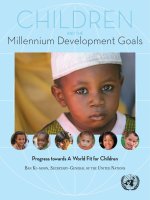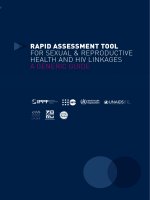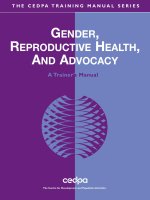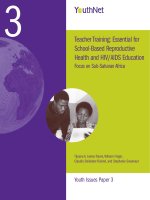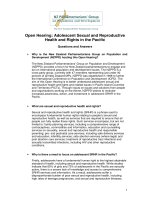Population, Reproductive Health and the Millennium Development Goals ppt
Bạn đang xem bản rút gọn của tài liệu. Xem và tải ngay bản đầy đủ của tài liệu tại đây (315.12 KB, 36 trang )
Messages from the UN Millennium Project Reports
June 2005
Population, Reproductive
Health and the Millennium
Development Goals
Population, Reproductive
Health and the Millennium
Development Goals
Messages from the UN Millennium Project Reports
June 2005
Report produced under the direction of Stan Bernstein
Copyright © 2005
by the United Nations Development Programme
All rights reserved
Photos: Front cover, top to bottom and left to right, Christopher Dowswell/UNDP,
Giacomo Pirozzi/Panos Pictures, Liba Taylor/Panos Pictures, Jørgen Schytte/UNDP.
This book was edited, designed, and produced by Communications Development Inc.,
Washington, D.C.
The UN Millennium Project was commissioned by the UN Secretary-General and sup-
ported by the UN Development Group, which is chaired by the Administrator of the United
Nations Development Programme. The report is an independent publication. This pub-
lication does not necessarily reflect the views of the United Nations, the United Nations
Development Programme, or their Member States.
Population, Reproductive Health and the Millennium Development Goals iii
Table of contents
Foreword iv
Introduction vi
Part One Millennium Development Goals 1
Part Two Sexual and Reproductive Health and Investing in Development:
A Practical Plan to Achieve the Millennium Development
Goals 3
Part Three Sexual and Reproductive Health and the UN Millennium Project
Task Force Reports 8
Part Four Two-page spread in Chapter 5 of Investing in Development, “Sexual
and reproductive health—essential for reaching the Goals” 14
Part Five Proposed SRH Targets and Indicators for Monitoring the
MDGs 19
Part Six A Guide to the Key SRH References in the UN Millennium
Project Documents 21
iv Population, Reproductive Health and the Millennium Development Goals
The world has an unprecedented opportunity to improve the lives of billions of
people by meeting the Millennium Development Goals (MDGs), the interna-
tional community’s time-bound and quantified targets for addressing extreme
poverty in its many forms. At the request of UN Secretary-General Kofi Annan,
the UN Millennium Project has identified practical strategies to meet the MDGs,
emphasizing the scaled up investments required in human capital and infra-
structure and environmental sustainability, alongside efforts to promote gender
equality.
The UN Millennium Project, an independent advisory body to the Secretary-
General, has been a unique undertaking. Its 10 Task Forces have brought together
a broad array of participants from academia, government, UN agencies, inter-
national financial institutions, nongovernmental organizations, donor agencies,
and the private sector, creating a worldwide network of development practitioners
across a wide range of disciplines.
It is therefore particularly striking that diverse groups of experts from differ-
ent sectors clearly and consistently recognized that expanded access to sexual and
reproductive health services and protection of reproductive rights are essential to
the achievement of the MDGs. The health-related goals (reducing child mortal-
ity; improving maternal health; reversing HIV/AIDS, tuberculosis and malaria)
are most clearly and directly affected. But access also has important impacts on
poverty and hunger, on gender equality and the empowerment of women, on
educational attainment, on environmental sustainability, and on the quality of
life of slum dwellers.
Dramatic disparities in access to comprehensive reproductive health infor-
mation and services are both a symptom of and a contributor to poverty and
gender inequality. Until the poor and marginalized—including youth and rural
Foreword
Population, Reproductive Health and the Millennium Development Goals v
populations—gain access to voluntary family planning, safe motherhood services,
and protection from sexually transmitted diseases, gender violence and harmful
traditional practices, and until all women reap the benefits of participation and
equality, progress against poverty will be handicapped.
The required interventions for sexual and reproductive health are clear, as
detailed in the UN Millennium Project’s reports, and they need to be urgently
implemented. They need to be sensitive to local cultural realities while following
the experience collected from population and reproductive health programs over
the past 40 years. Monitoring progress and achieving universal access to sexual
and reproductive health services is essential to the attainment of the MDGs.
Jeffrey D. Sachs
Director
UN Millennium Project
vi Population, Reproductive Health and the Millennium Development Goals
Introduction
The UN Millennium Project is the independent advisory body commissioned
by the UN Secretary-General to propose the best strategies for meeting the Mil-
lennium Development Goals (MDGs). The MDGs are the world’s targets for
reducing extreme poverty in its many dimensions by 2015—including income
poverty, hunger, disease, exclusion, lack of infrastructure and shelter—while pro-
moting gender equality, education, health and environmental sustainability. The
Project’s analytical work has been carried out by ten thematic task forces com-
prising more than 250 experts from around the world, including development
practitioners, national and international policymakers, as well as civil society and
private sector representatives.
Although there is no formal MDG outlining targets for sexual and repro-
ductive health (SRH), the MDGs cannot be achieved in low-income countries
without attention to population issues and access to SRH services. By placing
such emphasis on SRH issues in its recommendations, the UN Millennium Proj-
ect hopes these issues will become properly entrenched in programs to achieve
the MDGs.
Indeed, strong SRH-relevant messages and recommendations appear
throughout key UN Millennium Project documents—including the Millennium
Project Task Force reports, the report on the UN Millennium Project’s main
findings and recommendations, entitled Investing in Development: A Practical
Plan to Achieve the Millennium Development Goals, and its summary Overview
document. These reports were launched on 17 January 2005 and can be down-
loaded at .
This document outlines how the UN Millennium Project reports incor-
porate and promote sexual and reproductive health issues. This document also
provides a guide to finding the relevant SRH text in these reports.
Population, Reproductive Health and the Millennium Development Goals 1
Goal 1 Eradicate extreme poverty and hunger
Target 1 Halve, between 1990 and 2015, the proportion of people whose
income is less than $1 a day.
Target 2 Halve, between 1990 and 2015, the proportion of people who suffer
from hunger.
Goal 2 Achieve universal primary education
Target 3 Ensure that, by 2015, children everywhere, boys and girls alike, will
be able to complete a full course of primary schooling.
Goal 3 Promote gender equality and empower women
Target 4 Eliminate gender disparity in primary and secondary education, pref-
erably by 2005, and in all levels of education no later than 2015.
Goal 4 Reduce child mortality
Target 5 Reduce by two-thirds, between 1990 and 2015, the under-five mortal-
ity rate.
Goal 5 Improve maternal health
Target 6 Reduce by three-quarters, between 1990 and 2015, the maternal mor-
tality ratio.
Goal 6 Combat HIV/AIDS, malaria and other diseases
Target 7 Have halted by 2015 and begun to reverse the spread of HIV/AIDS.
Target 8 Have halted by 2015 and begun to reverse the incidence of malaria
and other major diseases.
Part One
Millennium Development Goals
2 Population, Reproductive Health and the Millennium Development Goals
Goal 7 Ensure environmental sustainability
Target 9 Integrate the principles of sustainable development into country
policies and programmes and reverse the loss of environmental
resources.
Target 10 Halve by 2015 the proportion of people without sustainable access to
safe drinking water and basic sanitation.
Target 11 Have achieved by 2020 a significant improvement in the lives of at
least 100 million slum dwellers.
Goal 8 Develop a global partnership for development
Target 12 Develop further an open, rule-based, predictable, non-discrimina-
tory trading and financial system (includes a commitment to good
governance, development and poverty reduction—both nationally
and internationally).
Target 13 Address the special needs of the Least Developed Countries (includes
tariff- and quota-free access for Least Developed Countries’ exports,
enhanced programme of debt relief for HIPCs and cancellation of
official bilateral debt and more generous ODA for countries commit-
ted to poverty reduction).
Target 14 Address the special needs of landlocked countries and small island
developing states (through the Programme of Action for the Sustain-
able Development of Small Island Developing States and the twenty-
second General Assembly provisions).
Target 15 Deal comprehensively with the debt problems of developing countries
through national and international measures in order to make debt
sustainable in the long term.
Target 16 In cooperation with developing countries, develop and implement
strategies for decent and productive work for youth.
Target 17 In cooperation with pharmaceutical companies, provide access to
affordable essential drugs in developing countries.
Target 18 In cooperation with the private sector, make available the benefits
of new technologies, especially information and communication
technologies.
Note: See Part Five for Task Force comments on Target 6.
Population, Reproductive Health and the Millennium Development Goals 3
Part Two
Sexual and Reproductive Health and
Investing in Development: A Practical
Plan to Achieve the Millennium
Development Goals
Below are six key findings and recommendations on population and sexual and
reproductive health (SRH) in the UN Millennium Project’s report on its main
findings and recommendations, Investing in Development: A Practical Plan to
Achieve the Millennium Development Goals, and its summary Overview docu-
ment. Also included are select citations from the text that exemplify these mes-
sages. [For a complete guide to SRH text in this report, please refer to Part Six
of this document.]
Ensuring universal access to sexual and reproductive health
information and services, including voluntary family planning, is
essential for achieving the MDGs
The Overview and Chapter 3 discuss poverty traps and areas of specific policy
neglect, such as gender equality and ensuring access to sexual and reproductive
health: “Also common are gender biases in public investment and social and eco-
nomic policies, maternal health and sexual and reproductive health. Adolescents
are also widely underserved for life skills, nutrition information, education and
employment opportunities and sexual and reproductive health information and
services. Throughout the developing world and even in middle-income countries,
maternal mortality rates remain appallingly high.”
Chapter 3—Box 3.1 (“Essential inputs for reaching the Goals”) highlights other
important international development objectives that are not included as one of
the MDGs, but that are crucial to the achievement of the Goals. This box high-
lights the importance of ensuring access to sexual and reproductive information
and services in the achievement of the MDGs.
4 Population, Reproductive Health and the Millennium Development Goals
Chapter 5—Box 5.5 (“Sexual and reproductive health—essential for reaching the
Goals”) is a two-page spread that highlights the key reasons why ensuring uni-
versal access to sexual and reproductive health information and services is neces-
sary for achieving the MDGs. “The current situation shows how devastating the
neglect of sexual and reproductive health can be. The differences in reproductive
health—between the rich and the poor and within and between countries—are
larger than in many other areas of healthcare…Sexual and reproductive health
services should be integrated into a strengthened health system.”
Gender equality is essential for achieving the MDGs
“Specific interventions to address gender inequality should be an intrinsic part
of all MDG-based investment packages. They should also address systematic
challenges such as protection of sexual and reproductive health and rights
(including access to information and family planning services), equal access to
economic assets such as land and housing, increased primary school completion
and expanded access to post-primary education for girls, equal labor market
opportunities, freedom from violence and increased representation at all levels
of governance. One essential step to addressing these systematic challenges is the
collection of gender-disaggregated data for monitoring progress.”
Recommendations
The Overview contains Ten Key Recommendations, which includes the bullet
point: “Focus on women’s and girls’ health (including reproductive health)
and education outcomes, access to economic and political opportunities,
right to control assets and freedom from violence.”
Chapter 5—Box 5.1 lists “Quick wins—solutions to implement now”
which contains the following bullet point: “Expand access to sexual and
reproductive health services, including family planning and contracep-
tive information and services, and close funding gaps for supplies and
logistics.”
Population, Reproductive Health and the Millennium Development Goals 5
A demographic-related poverty trap exists
Chapter 3—Box 3.2 (“The poverty-demography trap”) details the multiple link-
ages between extreme poverty and high fertility. It also highlights key policy
priorities for the voluntary reduction of fertility levels.
The Overview and Chapter 3 also highlight the linkages between poverty
and high fertility as follows: “Impoverished people living in rural areas have
the highest fertility rates and the largest families. Rapid population growth and
shrinking farm sizes make rural poverty worse. Poor people (in rural and urban
areas) have less access to information and services to space or limit their pregnan-
cies in accord with their preferences.”
Strong health systems are needed to ensure universal access to
basic health services
Equitable, well-functioning health systems are essential for achieving the Millen-
nium Development Goals, especially the maternal health goal. A fundamental
shift in the approach to health systems is needed.
Recommendation
“[Overcoming the poverty trap] is helped by a voluntary reduction in fertility,
which promotes greater investments in the health, nutrition, and education
of each child. We thus strongly support programs that promote sexual and
reproductive health and rights, including voluntary family planning.”
Recommendation
MDG planning frameworks should be designed around seven public
investment and policy clusters. The third investment cluster includes “health
systems to ensure universal access to essential health services.” It further
states that “Health interventions are best provided through an integrated
district health system centered on primary care and first-level referral hos-
pitals with special measures to ensure that the health system reaches all
groups in the population, including the poor and marginalized.”
6 Population, Reproductive Health and the Millennium Development Goals
Conflict, poverty and demography linkages exist
Chapter 3—Box 3.4 (“The poverty-conflict nexus”) proposes reasons for the
strong bidirectional linkages between poverty and conflict, including demogra-
phy and social structures. “Poorer countries are more likely to have demographic
regimes marked by high fertility and high mortality, resulting in low adult-to-
child ratios. Such demographic profiles are also associated with greater conflict
risks. Indeed since 1945 almost every instance of massive one-sided violence
(genocide or politicide) has occurred in countries with more than a two-to-one
child-adult ratio.”
Partnering between government, donors, civil society organizations
and the private sector is essential
“National strategies to achieve the Goals will not succeed without [civil society
organizations’] active engagement… Private businesses are important partners
in achieving the Goals.”
Recommendation
Governments need to work with civil society and the private sector to
achieve the Goals. The Overview states that “To achieve the Goals, gov-
ernments must work actively with all constituencies, particularly civil soci-
ety organizations and the private sector. Civil society organizations can
help design national strategies, deliver services, defend human rights and
supervise government in the fight against corruption and misrule.”
Population, Reproductive Health and the Millennium Development Goals 7
SRH-relevant interventions recommended for scaled-up
investment
Appendices 1 and 2 of Investing in Development include a variety of SRH-
relevant interventions under health, gender equality as well as in other
areas. Examples include universal access to sexual and reproductive
health services and information (including family planning, safe mother-
hood as well as prevention, treatment and care of STIs including HIV/AIDS),
age-appropriate education and services, attention to men’s involvement,
adolescent reproductive health and other life skills and education needs,
parental education, ensuring contraceptive choice, improving counseling,
combating gender violence, discouraging of early marriage, eliminating
female genital mutilation and other harmful traditional practices, expand-
ing access to safe abortion (where permitted by law) and reviewing of such
legislation to protect women’s health.
8 Population, Reproductive Health and the Millennium Development Goals
Part Three
Sexual and Reproductive Health and the
UN Millennium Project Task Force Reports
Below are the key findings and recommendations on population and sexual and
reproductive health in the UN Millennium Project Task Force Reports. Also
included are select references from the text that exemplify these messages [For
a complete guide to SRH text in these reports, please refer to Part Six of this
document.]
Task Force on Hunger
Halving Hunger: It Can Be Done
Gender equality is central to achieving the hunger goal. “Women are disproportionately
vulnerable to hunger. At the same time, women are responsible not only for the
bulk of agricultural production, but often for managing household nutrition and
the household economy. Ensuring gender equality, therefore, will not only improve
women’s own nutrition, but also that of their children and society as a whole.”
HIV/AIDS is exacerbating vulnerability to hunger in millions of chronically hungry
households. “The interactive threats of hunger and HIV/AIDS in parts of the
world are leading to complex humanitarian crises, whereby people affected by
AIDS are unable to grow food or work for a living. Moreover, malnourishment
weakens the immune system and strength of those with HIV/AIDS, making
them succumb more quickly to the disease.”
Recommendations
Access to SRH services, especially for birth spacing, is needed to improve
the nutritional status of women and children. “Ensuring universal access to
reproductive health services is essential for improving the nutritional sta-
tus of pregnant women and their children, in particular through the proper
spacing of births.”
Population, Reproductive Health and the Millennium Development Goals 9
Task Force on Education and Gender Equality
Towards Universal Primary Education: Investments, Incentives
and Institutions and Taking Action: Achieving Gender Equality and
Empowering Women
Gender equality is essential for achieving the MDGs and can be reached through seven
priorities for action, which have been identified by the Task Force. These seven prior-
ities include: strengthen opportunities for postprimary education, while simulta-
neously meeting commitments to universal primary education; guarantee sexual
and reproductive health and rights; invest in infrastructure to reduce women’s
and girls’ time burdens; guarantee property and inheritance rights; eliminate
gender inequality in employment by decreasing women’s reliance on informal
employment, closing gender gaps in earnings, and reducing occupational segre-
gation; increase women’s share of seats in national parliaments and local govern-
mental bodies; and combat violence against girls and women.
Gender equality cannot be achieved without guaranteeing women’s and girls’ sexual
and reproductive health and rights. “Increasing women’s and adolescents’ access to
a broad range of sexual and reproductive health information and services is one
of the seven priorities for action identified by this Task Force.”
Barriers to girls’ education need to be overcome to make schools more accessible and
secure for this population. “Given the particular barriers to girls’ education, spe-
cific interventions are needed to make schools more accessible and secure for
this population.”
Supplemental nutrition programs are needed for vulnerable groups
(including pregnant women, nursing mothers and children). “The Task Force
recommends supplemental feeding programs for underweight pregnant
women and nursing mothers. They also recommend exclusive breastfeed-
ing for up to six months to ensure optimal nutrition for newborns. Finally,
comprehensive school-based feeding programs may be an excellent plat-
form to improve schools, keep children healthy, and may serve as vehicle
for reaching the community, particularly pre-school children and pregnant
or lactating mothers.”
10 Population, Reproductive Health and the Millennium Development Goals
Task Force on Child Health and Maternal Health
Who’s Got the Power? Transforming Health Systems for Women and
Children
Unwanted pregnancies contribute directly to maternal mortality. One of every four
pregnancies is unwanted or mistimed. This fuels recourse to abortion, often
under unsafe conditions, or leads to pregnancies carried to term with less access
to ante-natal care or delivery care than for wanted pregnancies. “Put simply, if
a woman does not get pregnant, she will not die in pregnancy or childbirth.
Therefore, increasing access to methods to control fertility can have a significant
impact on the number of maternal deaths, by reducing the number of times that
a woman runs the risk that a fatal obstetric complication will occur.”
Adolescents, particularly girls, are particularly vulnerable to ill-health, and attention
needs to be given to their sexual and reproductive health needs. “For both biological
and social reasons, adolescents, particularly adolescent girls, are a vulnerable
group…Despite the importance of adolescents, their reproductive and sexual
health needs have long been ignored and their views silenced by decisionmakers
influencing health and education policy and programs.”
Equitable, well-functioning health systems (including access to emergency obstetric
care) are essential to reducing maternal mortality, and a fundamental shift in the
approach to health systems is needed. “Perhaps more than any other major child
health or maternal health condition—or any major communicable disease for
that matter—maternal mortality reduction depends on a facility-based health
system that functions.”
Recommendation
Additional SRH-relevant indicators should be used to monitor Goal 3—
proportion of demand satisfied and adolescent fertility rate (see Part Five
for detailed discussion).
Population, Reproductive Health and the Millennium Development Goals 11
Task Force on HIV/AIDS, Malaria, TB and Access to Essential
Medicines
Combating AIDS in the Developing World and Prescription for Healthy
Development: Increasing Access to Medicines
Special vulnerability of women and girls to HIV/AIDS exists and must be addressed.
“Prevention and care programs will fail if they ignore the underlying determi-
nants of the epidemic: poverty, gender inequality, and social dislocation. At a
minimum HIV/AIDS programs must take these sources of social vulnerability
into account; in the longer run they must be tied to efforts to reduce them.”
Investments in health systems are essential for achieving the HIV/AIDS goal. “The
Task Force believes that the greatest barrier to meeting the goal of widespread
access to treatment is the deplorable state of health systems in most of the hard-
est hit countries.”
Universal access to SRH services and information are an integral part of the AIDS
response. “The fight against HIV/AIDS and the broader struggle for reproductive
health should be mutually reinforcing. National governments should incorporate
universal access to reproductive and sexual health services and information as
Recommendations
Full access to sexual and reproductive health information and services is
needed for the health of women and children, and a rights-based approach
for this should be included in initiatives such as the Global Fund and the 3 by
5 Initiative. “A functioning district health system is critical for ensuring full
access to sexual and reproductive health information and services, which,
together with good nutrition, form the foundation of good health for women
and children. This includes access to contraception, since control over the
number and spacing of children can have profound impact on the health and
well-being of both women and their children. It also includes safe abortion
services, where legal, as well as information and services for preventing
and treating sexually transmitted infections, including HIV/AIDS.”
An additional SRH-relevant target and indicators should be used to monitor
various MDGs
(see Part Five for details).
12 Population, Reproductive Health and the Millennium Development Goals
an integral part of their AIDS responses. In addition, there should be greater
integration of HIV and other reproductive health services, including pMTCT,
VCT, family planning, and safe motherhood.” Note that the Glion and New
York declarations are cited.
Task Force on Environmental Sustainability
Environment and Human Well-Being: A Practical Strategy
Population growth is a key indirect driver of environmental degradation. “…And,
indeed, fertility is highest in the poorest countries as well as among the poorest
people in these and middle income societies. It is clearly then no surprise that
these same places have the highest levels of unmet need for family planning and
reproductive health services, which, in concert with other health, education and
gender equality issues, must be addressed with policies and programs to slow
population growth and realize synergistic improvements.”
Natural population growth is an important driver of urbanization. “…Population
growth, with continued levels of fertility higher than people say they desire con-
tributes both to natural growth in urban areas and to the factors pushing migra-
tion from rural areas to urban areas and new rural settlements.”
Recommendation
Strengthened links between family planning and HIV/AIDS programs and
services are needed. “The great majority of HIV infections are transmitted
sexually or during pregnancy, childbirth, or breastfeeding. The prevention,
diagnosis, and treatment of sexually transmitted infections is a core repro-
ductive health concern as well as important HIV prevention intervention.
Moreover, family planning programs have developed considerable knowl-
edge and tools for conveying information and influencing sexual behavior.
Thus there are abundant reasons to foster strong links between reproduc-
tive health and HIV/AIDS programs and services.”
SRH supplies need to be included on essential medicines lists. “National
essential medicines lists must contain the UNFPA/WHO–recommended
core medicines and devices for reproductive health.”
Population, Reproductive Health and the Millennium Development Goals 13
Task Force on Improving the Lives of Slum Dwellers
A Home in the City
Stark intra-urban health disparities exist, especially in terms of SRH outcomes.
“Poor urban women also have worse sexual and reproductive health outcomes
than other urban women, and at times, their outcomes rival those of rural resi-
dents…Poor urban women are also much less likely to use contraception than
other urban women, and again in some regions their usage rates resemble that
for rural women.”
High prevalence of sexually transmitted infections, including HIV/AIDS, exists in
urban settings. “The anonymity of city life, more permissive social and sexual
norms, the presence of sex workers along with other factors have contributed to
the high prevalence of STDs and HIV/AIDS in urban settings.”
14 Population, Reproductive Health and the Millennium Development Goals
Sexual and reproductive health is essential for reaching the Goals. It entails
healthy, voluntary and safe sexual and reproductive choices—voluntary choices
of individuals and couples about family size and family formation, including
early marriage and other exposures to sexual risks. Reproductive health issues
thus deal with vital (and frequently sensitive) concerns including sexuality, gen-
der roles, male and female power relations and social and personal identity.
The current situation shows how devastating the neglect of sexual and
reproductive health can be. The differences in reproductive health—between
the rich and poor, both within and between countries—are larger than in many
other areas of healthcare (Gwatkin and others 2003; Bernstein 2004). Maternal
mortality takes some 529,000 lives a year. Of those deaths, around 68,000 are
due to unsafe abortion [totaling 13% of maternal deaths], a sign of the need for
better access to higher quality family planning services to prevent unwanted
pregnancies and (where permitted by law) to safe abortion services.
Levels of unplanned or ill-timed fertility are high in many countries. The
unmet need for family planning comprises women at risk of pregnancy who do
not desire another birth (limiting desires) or who wish to space their birth at least
two years (spacing desires) but who are not using a method of family planning.
An estimated 29% of women in developing countries have an unmet need for
modern contraception. The highest proportion is in Sub-Saharan Africa, where
46% of women at risk of unintended pregnancy are using no method. Adding
those using traditional methods to those with unmet need for modern methods
brings to 63% the proportion of Sub-Saharan women and couples who have
unmet limiting and spacing desires (Singh and others 2004).
Part Four
Two-page spread in Chapter 5 of Investing
in Development, “Sexual and reproductive
health—essential for reaching the Goals”
Population, Reproductive Health and the Millennium Development Goals 15
But promoting reproductive health requires more than simply delivering
services and information to prevent disease and reduce risk. It includes:
• Family planning, including access to modern contraceptives and
informed and voluntary choice of family planning methods.
• Safe motherhood, including antenatal, postnatal and normal delivery
services and emergency obstetric care.
• Postabortion care and access to safe abortion, where permitted by law.
• A continuum of prevention, treatment and care for HIV/AIDS and
other sexually transmitted infections.
• Prevention, surveillance and care for gender-based violence.
• Action against harmful traditional practices, such as female genital
mutilation and early and/or coerced marriage.
• Information and services for underserved populations, including
diverse groups of adolescents, people in emergency situations and men
(Singh and others 2004).
Each of these elements affects progress toward the Goals. Some examples:
• Goal 1: Eradicate extreme poverty and hunger. Smaller families and longer
birth intervals, a result of contraceptive use, allow families to invest more
in each child’s nutrition and health. That can reduce poverty and hunger
for all members of a household. At the national level, voluntary reduction
of birth rates may enable faster social and economic development.
• Goal 2: Achieve universal primary education. Families with fewer chil-
dren, and children spaced further apart, can afford to invest more
in each child’s education. This has a special benefit for girls, whose
education may have lower priority than that of boys in the family. In
addition, girls who have access to contraceptives are less likely than
those who do not to become pregnant and drop out of school.
• Goal 3: Promote gender equality and empower women. Controlling
whether and when to have children is a critical aspect of women’s
empowerment. Women who can plan the timing and number of their
births also have greater opportunities for work, education and social
participation outside the home.
• Goal 4: Reduce child mortality. Prenatal care and the ability to avoid
high-risk births (such as those to very young women and those spaced
16 Population, Reproductive Health and the Millennium Development Goals
closely together) help prevent infant and child deaths. Children in
large families are likely to have reduced healthcare, and unwanted chil-
dren are more likely to die than wanted ones.
• Goal 5: Improve maternal health. Preventing unplanned and high-risk
pregnancies and providing care in pregnancy, childbirth and the post-
partum period save women’s lives.
• Goal 6: Combat HIV/AIDS, malaria and other diseases. Sexual and
reproductive health care includes preventing and treating sexually
transmitted infections, including HIV/AIDS. In addition, reproduc-
tive health care can bring patients into the healthcare system, encour-
aging diagnosis and treatment of other diseases and conditions.
• Goal 7: Ensure environmental sustainability. Providing sexual and
reproductive health services, and avoiding unwanted births, can help
stabilize population numbers in rural areas, slow urban migration and
balance natural resource use with the needs of the population.
• Goal 8: Develop a global partnership for development. Affordable prices
for drugs to treat HIV/AIDS and a secure supply of contraceptives
would greatly advance reproductive health programs in all developing
countries.
Reproductive health approaches give heightened priority to strengthening
prevention efforts while recognizing the importance of a full spectrum of preven-
tion, treatment and care to improving the linkages between these service systems.
Action in sexual and reproductive health also encompasses an analytic and
programmatic framework, based on a human rights approach, rooted in stronger
health systems, supported by communities and accompanied by complementary
interventions in other sectors. Promoting reproductive health thus requires a
broad range of interventions that facilitate access to information and services,
increase gender equality and empowerment, involve communities and cultural
leaders, strengthen health delivery systems at multiple levels, create effective
referral systems and improve logistics and management.
There are numerous channels to integrate sexual and reproductive health
services in a strengthened health system. For example, maternal and child health
Population, Reproductive Health and the Millennium Development Goals 17
services can provide an opportunity for family planning information programs,
referrals and services. Integrated maternal health, family planning and child
healthcare services should add appropriate personnel and increase referral
capacities. HIV/AIDS prevention can be better linked with other reproductive
health information and service interventions. Health system contacts for abor-
tion, where permitted by law, and for treating postabortion complications also
provide entry points for family planning service delivery should include a range of
contraceptive options to meet the needs of specific populations and accommodate
choice and appropriate method-switching.
A large cohort of adolescents—1.3 billion, mostly in less developed
countries—will require new approaches to information and service delivery, as
14 million births are to adolescent girls (12.8 of which are in developing coun-
tries). Youth-friendly services will require separate facilities addressing a complex
of life skill needs—including productive and entrepreneurial skills for employ-
ment, literacy and numeracy training and nutrition and health information,
including that for reproductive health. They will also require specially trained
staff sensitive to the needs of the young. Curriculum reform must be undertaken
to make age-appropriate materials, acceptable in the local context, available in
school systems.
Promoting gender equality and respect for human rights together with
building skills (including self-esteem, self-confidence and negotiation skills, par-
ticularly for young women) is important for protecting young people and devel-
oping their capacities. Mass media, folk media, and other information outreach
approaches must be expanded to reach the large number of out-of-school young.
Working with existing institutions, parents, parent groups and cultural leaders
can make information and services more effective for young people.
Male reproductive health needs and the role of men in supporting women’s
reproductive health is another area for priority attention (Greene and others
2005). Local efforts have produced significant improvements in antenatal care,
in using skilled birth attendants and in contraceptive acceptance. They demon-
strate the potential of scaling up these efforts. Service delivery to men (and their
families) in the military and police forces has also been important in scaling up

